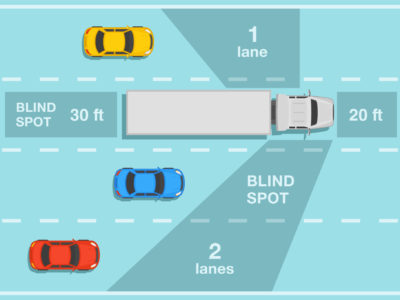Regardless of the vehicle you drive or the type of roadway you are on, it is crucial to be attentive, alert, and aware of your surroundings at all times when you are behind the wheel. This is especially true when passing through a construction zone.
Construction zones require drivers to reprioritize certain aspects of their driving, including their speed, the signs they pay attention to, and the path of the road that may have been adjusted because of the current construction work.
Construction zones can sometimes create a sense of unease for drivers due to factors like:
- Active or inactive construction equipment
- Adjusted drive lines
- New road signs
- Speed changes
- Surrounding traffic, including 18-wheelers
- Workers in action at the job site
Even on a perfectly clear roadway, sharing the road with an 18-wheeler, or semi-truck, requires drivers to take extra precautions. Come upon a construction zone, and you should become even more attentive, or else you could experience a semi-truck accident.
Some Facts About 18-Wheelers
18-wheelers are massive. This is not new news or a big revelation, but it is something people can forget to keep in mind when on the road. 18-wheelers are 20 to 30 times heavier than a passenger vehicle like a sedan, SUV, or truck. When the cab is pulling one standard trailer, the truck is about 4 times longer, 2.5 times taller, and 1.4 times wider than an average mid-sized car. Even if you are driving a large, full-sized pickup, your vehicle’s size pales in comparison to the size of an 18-wheeler.
18-wheelers require more force and more time to slow down than you. Because of its weight, an 18-wheeler needs extra time and distance to brake safely. In ideal conditions, a fully loaded 18-wheeler traveling at 60 miles an hour will need about 600 feet to come to a complete stop. In the same conditions and traveling at the same speed, a regular vehicle only needs about 300 feet to come to a complete stop.
18-wheelers have significant blind spots. Truck drivers sit roughly 10 feet off the ground and can only use 3 windows—the windshield and driver and passenger door windows—to look directly out. The rest of their views of surrounding traffic depend solely on mirrors. Without any rear view of what is behind them, limited mirror capabilities to see what is surrounding them, and major height differences between themselves and other drivers on the road, semi-truck drivers must operate with significant blind spots.
How to Share the Road with an 18-Wheeler Safely While in a Construction Zone
Whenever crossing through a construction zone with 18-wheelers nearby, follow these helpful safety tips to ensure you, your passengers, and your surrounding drivers remain safe and accident-free:
Pay Attention to Surrounding 18-Wheelers When Approaching a Construction Zone
First and foremost, you need to know when you are near an 18-wheeler and where you are relative to where they are. You could be directly in front of, beside, or behind a semi-truck; and, in many situations, you could be driving around multiple trucks at once.
Know what vehicles are around you and adjust your driving accordingly.
Avoid an 18-Wheeler’s Blind Spot
Remember, 18-wheelers have major blind spots, four to be more specific:
Driver’s Side Blind Spot: On the truck driver’s left side, the blind spot stretches from the driver’s door to about halfway down the trailer in the adjacent lane. The driver’s mirrors do not provide a clear view of this area, and the driver cannot simply turn their head to “see out of the back.”
Passenger’s Side Blind Spot: On the truck’s passenger side, the blind spot stretches from the door window to about halfway down the trailer and outwards into the adjacent lane.
Rear Blind Spot: Behind the truck, the blind spot starts at the backside of the trailer and extends out 30 feet.
Front Blind Spot: In front of the truck, the blind spot starts at the front bumper and extends forward 20 feet.

Avoid these areas when driving near an 18-wheeler, even when passing through a construction zone.
Pay Attention to the 18-Wheelers Near You When Merging or Facing a “Choke Point”
Many construction zones require vehicles to merge into certain lanes. For instance, if the construction zone is taking place in lane 1, all vehicles in lane 1 must make their way into lane 2. Whenever merging is required, a choke point forms where vehicles that have not yet merged can no longer move forward and must shift lanes or become stuck.
Merging or navigating a choke point should be performed with lots of precaution, especially when 18-wheelers are nearby. If you are not merging but notice a semi-truck needing to merge, create the space it needs to move over safely, and carefully maneuver away from any blind spots if the merge causes you to enter one.
If you are involved in a semi-truck accident, turn to the expert attorneys at Clark, Smith & Sizemore.
Whether your accident with an 18-wheeler occurred in a construction zone or not, our semi-truck accident attorneys will thoroughly investigate your case and will fiercely represent you in the fight for justice. Call us today for a free consultation: 478-254-5040
Thank you for checking out part 1 of our 6-part series on semi-truck accidents. Stay tuned for our upcoming articles:
- Safety Tips for Driving Near an 18-Wheeler in a Construction Zone
- Avoid These Moves When Sharing the Highway with a Semi-Truck
- Warning Signs of Erratic Driving: Semi-Truck Edition
- Maximize Road Safety by Recognizing These Semi-Truck Blind Spots
- Can Bad Weather Increase My Chance of a Semi-Truck Accident?
- What to Do if You experience a Tractor-Trailor Accident
